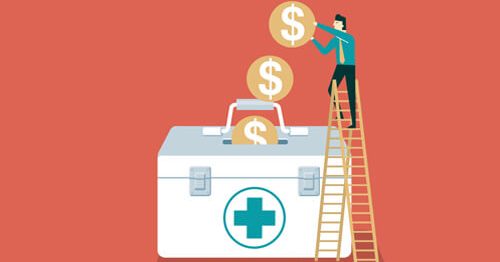Not many of us have health insurance that covers our medical expenses with low or no deductible (the amount you pay out of pocket before you’ll receive the full benefits of your insurance policy). In fact, the 2018 Kaiser Family Foundation Employer Health Benefits Survey showed that families with employer-sponsored health insurance pay an average of $5,547 per year in insurance premiums. Then there’s the average annual deductible of $1,573 per person, plus an average of $1,200 per year on pharmaceutical products.
With figures like the above, it pays to do what you can to cut the costs of your health care. Below are four tips to take charge of your medical costs.
1. When Possible, Use In-Network Providers.
An in-network provider is a physician, hospital or other facility that accepts your insurance, who has agreed to accept a discounted rate. A provider that is out of the network doesn’t have a contract with your health insurance provider, which means you will likely pay full price for their services, which can be significant.
Let’s say you make an appointment with a doctor, who in turn orders tests at a hospital. The total bill is $17,500, and your insurer has set $12,000 as the amount it will pay for procedures with those billing codes.
If the hospital is in-network, your insurer will pay $12,000, but you will not be required to pay the remaining $5,500. If the hospital isn’t in the network, you will be responsible for the rest of the bill out of your pocket.
Verifying that your provider accepts your health plan but is also in-network can make a world of difference in your final bill.
2. Shop Around for Facilities and Providers.
Your doctor may refer you to a specific lab or clinic for a blood test or colonoscopy, but it’s important to understand that you don’t necessarily have to use it. If the procedure isn’t an emergency and time allows, stop into the provider’s office and show the staff your referral, then ask for the cost of the procedure and the billing code. A call to your insurance carrier will also verify how much of your deductible you have paid for the year, whether the procedure is covered by insurance, and the percentage of the cost insurance will pay.
With that information in hand, do some old-fashioned legwork to find out what other clinics charge. By providing the billing code, you should receive an accurate estimate from each provider. Once you have the prices, check online reviews to be sure you’re satisfied with the provider you have chosen and make an appointment.
3. Save Money on Prescriptions.
While the annual costs of prescriptions and pharmacy products can be daunting, there are ways to save money.
- Your doctor may be able to prescribe generic medication. The U.S. Food and Drug Administration tests generic drugs to ensure they are of the same quality and offer the same benefits as brand-name drugs. In 2016, Americans saved $253 billion by using generic medicines, and $1.67 trillion over a 10-year period. An example of the price difference: A 30-day supply of the cholesterol drug Lipitor can cost $375. Its generic equivalent, Atorvastatin, is just $11.70.
- Some drugs are cheaper if you order them in a 90-day quantity instead of a 30-day supply. You might pay $10 a month for a generic drug, but a 90-day supply might cost $15, saving you $15 over that time span.
- No-cost discount programs can help you to save money on prescriptions. GoodRx, Single Care and FamilyWize are popular sites to check. By signing up on these sites, you will receive a discount card to present at the pharmacy, making you eligible for savings. Some sites also have drug lookup pages that allow you to comparison shop local pharmacies.
- Some manufacturers also provide coupons to defray costs. Manufacturers of some drugs, including insulin, offer them on their websites. These coupons can be combined with your health insurance, but they typically don’t work with Medicare or Medicaid.
- Ask local pharmacies which discount programs they offer. Some offer special pricing on generic medications, such as $4 per month or $10 for a 90-day supply. Some pharmacies may also offer “freebies,” like syringes and lancets for diabetics.
4. Maximize Your Insurance Benefits.
Your health insurance plan could have some built-in benefits you didn’t know you had. For example, many health plans offer a free 24-hour nurse line or low-cost access to virtual doctor visits, saving you a trip to urgent care—and the accompanying bill. Some cover, either in full or at a discounted rate, things such as smoking cessation, weight-loss programs, gym memberships or even personal fitness tools, such as step counters.
It also pays to investigate Health Savings Accounts (HSAs) and Flexible Spending Accounts (FSAs) during your company’s open enrollment period. These savings accounts are offered by many employers and can help you cover out-of-pocket health care expenses by setting aside tax-free funds each pay period.
Medical expenses can eat a huge part of a family’s budget, but with a little planning and some shopping around, you can cut your bills substantially.






Comments Section
Please note: Comments are not monitored for member servicing inquiries and will not be published. If you have a question or comment about a Quorum product or account, please visit quorumfcu.org to submit a query with our Member Service Team. Thank you.